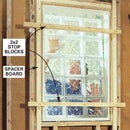Introduction: How to Use a Circuit Tester
Use the two-lead circuit tester to check for voltage. Place one lead on a live/hot wire (usually black, but can be any color other than green or white) and the other on a neutral (white) or ground (green or copper) wire, and the tester's light will turn on. This confirms that you have a good, complete circuit. If there's no light, the circuit is bad or the power is off.
If you live in an older home, use the circuit tester to check that all ground wires (usually green or bare copper) are actually connected to ground. This is necessary when replacing old, ungrounded switches with newer grounded ones.
Here's the easy way to test a ground wire:
- Turn off the switch's power at the main panel, and check with the voltage tester
- Uncap the neutral wires (OK to leave them bundled)
- Disconnect wires from the switch, and bend them apart so they can't touch each other
- Switch power back on at the main panel, and use the voltage tester to identify the hot wire
- Check the circuit tester by touching one lead to the hot wire (carefully!), and one to a neutral wire. If it lights up, the tester is working properly.
- Check the ground wire by touching it with one lead, and touching the hot wire with the other. A light indicates that the wire is properly grounded.
If you're working with a metal box without a ground wire, check whether the box itself can serve as ground. Follow the procedure above, but on the last step touch one lead to the box and the other to the hot wire. A light means the box is grounded; otherwise you'll need to check with an electrician or other expert to help you ground the box properly.
Follow a similar procedure when working with metal boxes in which no ground wire comes into the box. In this case, you want to find out whether the metal box itself is grounded (through conduit or another method) and will therefore serve as the required ground.
Warning: be careful of live wires! Don't touch the hot wire, or let it touch anything else. Be sure to hold the insulated portion of the tester leads while in use, and turn the circuit off again as soon as possible after testing.
For mor information of electrical projects check out The Family Handyman - Electrical
- By the DIY experts of The Family Handyman Magazine













